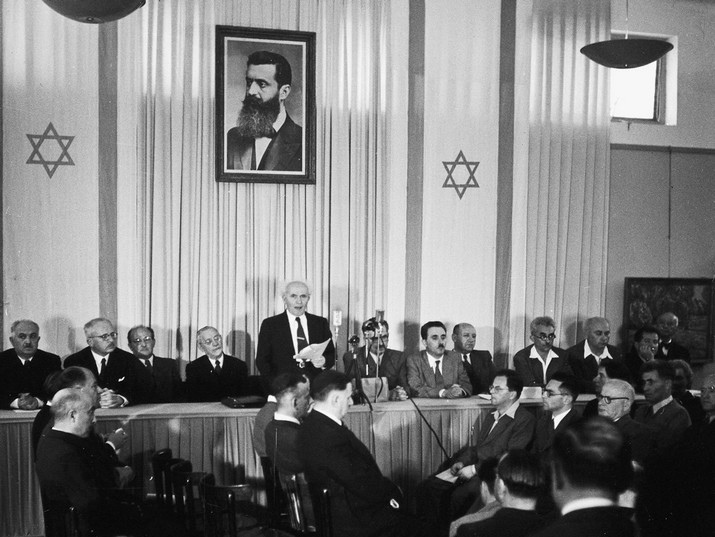The Jewish community of Izmir (Smyrna) was one of the most important Jewish communities in the Ottoman Empire. Jews from Salonika, Constantinople, and neighboring towns moved to Izmir because from the beginning of the 17th century it was a flourishing center of Mediterranean commerce. The local Jewish population included prosperous merchants and prominent rabbis. Many of Izmir's Jews were engaged in the manufacture of wool from goats' fleece. The leadership of the community consisted of two main bodies: the Beth Din who acted as a legal court and the Community Council that was responsible for the administrative functions of the community, including collection the taxes. In the second half of the 19th century, the community adopted more democratic methods of governance that lead to the introduction of some limits to the authority of the chief rabbi. At the end of the 19th century a general decline of Izmir Jewry set in and many of the Jewish residents moved to Greece, France and the United States. After World War I Jews emigrated to South America, and between 1948 and 1950 many emigrated to Israel. The collection contains materials from late 18th century to 20th century. There are records related to the legal status of the Jews as a minority and documents concerning the community's relations with the authorities, including correspondence with the authorities. The collection contains numerous materials regarding organization and management of the community: reports on the situation of the community; documents regarding elections to the community’s committee; minutes of meetings of the community’s committee; correspondence of the committee within Izmir, with foreign consulates and with other Jewish communities in Turkey and the world; documents regarding the financial conditions of the community; and records concerning real estate and construction. An important part of the collection is materials related to the Jewish religious life in Izmir including correspondence on providing matzah, approval for brit milah (1928-1929), ledgers of Aliyot to the Torah, letters and Pinkassim (Jewish minute books) of the Beth Din from the 19th-20th centuries. There are documents of vital data of the Jewish residents, materials on Jewish education, cultural life and welfare system of the community including providing of medical care. The collection also holds documents of Jewish organizations (Bnei Brit, Association of fabrics’ merchants), and various documents and letters belonging to the Ashkenazi family --

| Title |
Jewish community of Izmir. |
|---|---|
| Contributors |
Shabbethai Tzevi, 1626-1676 |
| Host Item |
Izmir - Jewish Community |
| Level of Description |
Fonds Record |
| Biographical summary |
Izmir (Smyrna), located on the coast of the Aegean Sea, is the provincial capital and principal harbor of Western Anatolia, and the third largest city in the Republic of Turkey. The development of Izmir dates from the beginning of the 17th century, when it was a flourishing center of Mediterranean commerce. Most of the new Jewish settlers who came to Izmir were Sephardi refugees, while others arrived after first settling in other cities in the Ottoman Empire: Istanbul, Salonika, Crete, Corfu, Janina and Ankara. Jews were compelled to pay a special tax to the Ottoman authorities that promised them protection for their lives and property. Yeshivot, schools, synagogues and a Hebrew printing press was established in Izmir in1658. The local Jewish population included merchants, translators, agents of European merchants, banks and consulates, customs officials, usurers and eminent rabbis. Shabbetai Zevi was born in Izmir and began his activities there. The welfare system of the community was established between the 16th and 18th centuries. Bikur Holim ("visiting the sick"), Ozer Dalim, Hachnasat Orchim associations together with modern institutions – pharmacies, hospitals — were active in the 19th century. European Jewish merchants who arrived in Izmir and the establishment of the “Universal Israelite Alliance” schools from 1873, strengthened the influence of westernization within the Jewish community. The local Jewish theater performed original plays in Ladino and foreign plays in their original language. In the 19th century, there were 15,000–20,000 Jews in Izmir, and between 1864 and 1901 there were six cases of blood libels against the Jews in the city. At the end of the 19th century a general decline of Izmir Jewry set in. After the Turco-Greek War (1919–1921), many Jews left the town for Greece or emigrated to France and the United States. With the enforcement of the Tanzimat regulations and the legislation of the Chief Rabbinate Law in 1865, the prestige of the rabbis began to decline. After World War I, many emigrated to South America, and between 1948 and 1950, about 10,000 went to Israel. |
| Language Note |
Turkish Ottoman Turkish Ladino French Italian Hebrew English Spanish |
| National Library system number |
990047579920205171 |
| Links |
פרטים על מיקום החומר/Location&access |
-
-
-
-
-
-
-
-
-
-
-
-
-
-
- Show Next 10 Items out of 78
- Show All
-
-
-
-
-
-
-
תנאי השימוש:
Appropriate Conditions of Use Have Been Established for Every Archive File
The terms of use appear on the archival file page on the National Library website.
For more information about the copyright status inquiry service and terms of use for items from the Library’s collections, click here.
MARC RECORDS
Have more information? Found a mistake?

 Sign in with Google
Sign in with Google
 Sign in with Facebook
Sign in with Facebook



